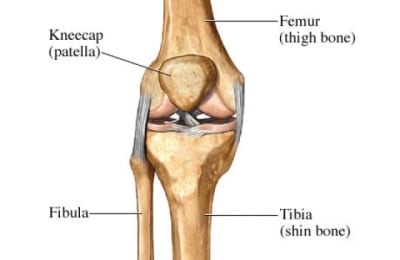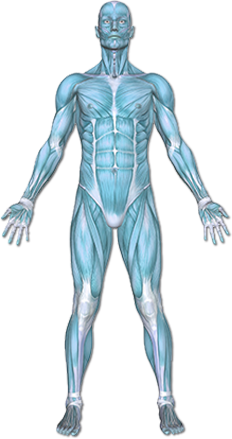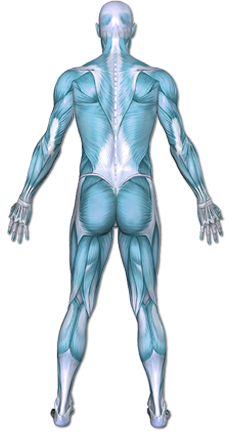Patellofemoral Pain Syndrome
Patellofemoral pain syndrome is a condition in which pain is felt under the kneecap. The patella is the bone that makes up the kneecap. The femur is the thigh bone. This bone forms the upper part of the knee. In people with patellofemoral pain syndrome, the patella rubs painfully against the femur.
This pain occurs during exercise or movement. It is most common during weight bearing activities such as running.


Copyright © Nucleus Medical Media, Inc.
This content was created using EBSCO’s Health Library
The pain is the result of inflammation of soft tissues around the kneecap. It can be due to a number of different factors or conditions, such as overuse and improper use of the legs.
This content was created using EBSCO’s Health Library
The following factors increase your chance of developing patellofemoral pain syndrome.
- Malalignment of the knee joint caused by:
- Rolling your feet outward during walking or running — can pull the kneecap out of line and cause painful rubbing of the kneecap against the bones of the knee
- The kneecap being located too high or too low in the knee joint
- Loose ligaments
- Poorly aligned bones
- Weak or tight thigh muscles causing:
- Inability to hold the kneecap in the correct position
- The kneecap to rub against the femur during movement
- Overuse and overloading the knee joint from:
- High-impact sports or activities, such as running that result in ponding on the feet
- Knock knees
- Flat feet
- High arches
- Hip dysfunction
- External rotation of the lower leg
- Trauma, such as an automobile accident where the kneecap hits the dashboard
This content was created using EBSCO’s Health Library
The first symptom is pain around or under the kneecap. The pain may first occur during high-impact activities. As the condition gets worse, the pain may be triggered by squatting, kneeling, or long periods of sitting. It is thought to be caused by the pressure on the kneecap while the leg is flexed. It is often increased by going down stairs or down hills. If you have knee or joint pain during activity, call your doctor. Other symptoms may include:
- Swelling of the knee
- Popping or grinding sounds in the knee joint during activity
- A snapping sensation in the knee
This content was created using EBSCO’s Health Library
This content was created using EBSCO’s Health Library
This content was created using EBSCO’s Health Library
It may not be possible to totally prevent this condition. There are steps you can take to reduce your risk and avoid making the condition it worse, including:
- Proper warming up before exercising. This includes stretching after warm-up and post-activity. This will help to prevent sports-related injuries.
- Vary the types of activities that you participate in. For example, rather than running or jogging every day, alternate between running and swimming.
- Use appropriate footwear for your sport.
- Increase the amount and effort of activities slowly over time.
- Use proper form and technique for any sport.
- Take care of injuries right away. This includes getting first aid and resting the injury until it is healed before beginning an activity again.
This content was created using EBSCO’s Health Library
This content was created using EBSCO’s Health Library
RESOURCES:
- American Academy of Family Physicians
http://familydoctor.org
- American Academy of Orthopaedic Surgeons
http://orthoinfo.aaos.org
- The President’s Council on Fitness, Sports, and Nutrition
http://www.fitness.gov
CANADIAN RESOURCES:
- Canadian Orthopaedic Association
- Health Canada
http://www.hc-sc.gc.ca
REFERENCES:
- Juhn MS. Patellofemoral pain syndrome: a review and guidelines for treatment. Am Fam Physician. 1999; (60)7: 2012-2022.
- Labella C. Patellofemoral pain syndrome: evaluation and treatment. Prim Care Clin Office Pract. 2004; 31: 977-1003.
- Patellofemoral pain syndrome. Am Fam Physician. 1999 Nov 1;60(7):2019-2022. Available at: http://www.aafp.org/afp/991101ap/991101b.html Accessed May 3, 2013.
- Patellofemoral pain syndrome. EBSCO DynaMed website. Available at: http://www.ebscohost.com/dynamed Updated November 27, 2012. Accessed February 18, 2014.
- 1/24/2011 DynaMed’s Systematic Literature Surveillance http://www.ebscohost.com/dynamed: Fukuda TY, Rossetto FM, Magalhães E, Bryk FF, Lucareli PR, de Almeida Aparecida Carvalho N. Short-term effects of hip abductors and lateral rotators strengthening in females with patellofemoral pain syndrome: a randomized controlled clinical trial. J Orthop Sports Phys Ther. 2010;40(11):736-742.
This content was created using EBSCO’s Health Library


